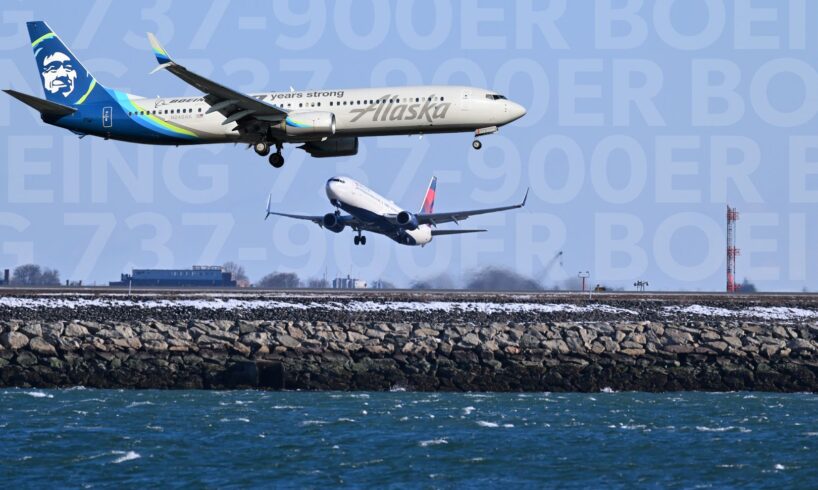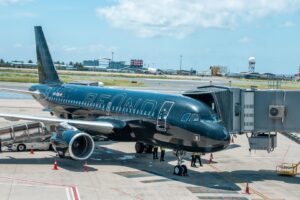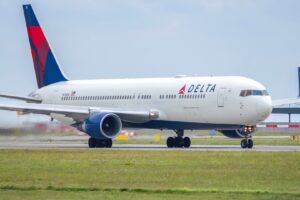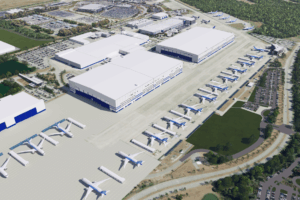
Usually, the Boeing
737-900ER needs a takeoff roll of about 2000 meters, or 6560 feet. That is the distance that the aircraft must travel to reach its lift-off speed and take off from the tarmac. The necessary takeoff distance may be significantly greater under maximum takeoff weight or hot weather, and at high elevation fields. Possibly even approaching 3000 meters (about 9840 feet).
Boeing 737-900
Length
138 ft 2 in (42.11 m)
Wingspan
112 ft 7 in (34.32 m)
Height
41 ft 3 in (12.55 m)
Engine Options
CFM International CFM56-7B27
Range
3,205 NM (5,940 km)
Expand
United Airlines’ purchase of 100 Boeing 737 MAX 9
s and 50 Next-Generation (NG) 737-900ER (Extended Range) aircraft in July 2012 made the 737 the first commercial jet aircraft to reach the 10,000 order milestone. The -900ER actually far outstripped the popularity of its standard predecessor, the -900, which saw relatively low sales. Alaska Airlines
, the launch customer, is expected to finish retiring its fleet of -900s this year, according to Airline Geeks.
Now, without spinning our wheels too much, let’s explore why the -900ER Take-off Run Required (TORR), or the Take-off Distance Required (TODR), is just so long!
Overview Of The -900ER
Previously known as the 737-900X, the 737-900ER was the last, largest model of the Boeing 737 NG series. Following the discontinuation of the 757-200, it was launched to solve the shortcomings of the 737-900, close the range and passenger capacity gap in Boeing’s model line, and compete with the Airbus A321.
The ER jet’s range was enhanced over the standard 737-900 model with two auxiliary fuel tanks in the cargo hold and the addition of winglets. The maximum seating capacity could be raised to 220 people with the installation of two additional doors.
The primary operators of the Boeing 737-900ER per Planespotters:
The Boeing 737-900ER’s launch customer was Lion Air. They received the first 737-900ER in April 2007. Since then, Delta Air Lines has become the largest customer and operator of the aircraft, with a significant fleet that includes aircraft that were originally flown by Lion Air. Other airlines, including Alaska Airlines, KLM, Jet Airways, Korean Air, Shenzhen Airlines, and United Airlines, also ordered the 737-900ER.
Despite the resounding success that the -900ER experienced and its milestone sales, the new 737 MAX family has surpassed it as the successor to the model family line. The MAX line delivers more refined technology that builds upon progress pioneered by the 737 NG line.
Photo: Aero Icarus | Flickr
A fully fueled 737-900ER tips the scales at 85,130 kg (188,000 lb). Each CFM56-7B27B delivers 126 kN (28,400 lbf), producing a thrust-to-weight ratio of 0.30. Acceleration suffers,, extending balanced field length and sometimes forcing payload limits.
Door frames, slides, and supporting structures contribute to empty mass behind the wing box. The extra aft weight reduces elevator authority during the rotation maneuver; the result is a raised rotation speed (Vr), but that lengthens the take-off (T/O) roll quite a bit.
The structural additions pushed Boeing to flatten the aft pressure bulkhead, gaining one extra seat row but further aft-shifting the center of gravity. That change forces operators to respect tighter cargo-loading rules, often leaving the rear hold partly empty when the front hold carries heavy pets or mobility equipment. Every kilogram moved forward shortens the runway bite by a measurable amount on takeoff roll.
Related
Where Can You Fly On Delta Air Lines’ Boeing 737-900ERs From New York-JFK?
One of the routes only has one flight operated by the narrowbody this month.
High Tail Strike Risk
The 737-900ER is more susceptible to tail strikes due to its longer fuselage and lower pitch attitude limits. Tail strikes can cause significant damage and are often caused by pilot error or unstable approaches. The longer fuselage makes it more susceptible to tail strikes, especially during landing, especially when the aircraft bounces on the runway.
The Seattle Times reported in January 2023 that two Alaska Airlines 737s, one a MAX 9 and the other a -900ER, had tail strikes just minutes apart in Seattle. Bret Peyton, the Director of Operations, ceased all flights for the day due to the extremely rare situation.
“At that point, two in a row like that, that’s when I said, ‘No, we’re done. That’s when I stopped things.”
Tail strikes are more likely during takeoff, but can also cause serious structural damage if they occur before the landing gear touches down. Factors contributing to tail strikes include unstable approaches, excessive approach energy, floating along the runway, and crosswind mishandling. Damage to the aft pressure bulkhead can result in extensive repairs.
Related
Delta Air Lines’ Top 10 Busiest Boeing 737-900ER Routes From Atlanta
Delta maintains the largest fleet of 737-900ERs, which uses to serve its busiest domestic routes.
By The Numbers
As the longest models in the 737 Next Generation family, the Boeing 737-900 and 737-900ER have identical fuselage lengths. But compared to its successor, the 737-900 is less flexible in terms of seating and range. The 2001-introduced 737-900’s maximum passenger capacity of 177 was constrained by the absence of extra escape doors. Additionally, its range was limited, which reduced its competitiveness for airlines looking to operate transcontinental trips efficiently.
These restrictions were resolved with the 2007 introduction of the 737-900ER. In a high-density arrangement, it incorporated two Type II over-wing escape doors, enabling a certified seating capacity of up to 220. In addition, the ER’s auxiliary tanks allow it to carry additional fuel, increasing its range to about 3,200 nautical miles, or about 500 more than the original 737-900. To increase aerodynamic efficiency, winglets were added as an optional or standard feature.
To really break down the exact differences between Boeing’s winglet-less 737-900 and extended range -900ER, let’s review the technical details line by line. Spec comparison courtesy of AviatorJoe.net:
Boeing 737-900ER
Versus
Boeing 737-900
42.10 m / 138 ft 1 in
Length
42.10 m / 138 ft 1 in
35.80 m / 117 ft 5 in
Wingspan
35.80 m / 117 ft 5 in
125.00 m2 / 1,345 ft2
Wingarea
125.00 m2 / 1,345 ft2
12.50 m / 41 ft
Height
12.50 m / 41 ft
2
Engines
2
126 kN / 28,400 lbf
Thrust Per Engine
121 kN / 27,300 lbf
252 kN / 56,800 lbf
Total Thrust
242 kN / 54,600 lbf
85,130 kgs / 188,000 lbs
MTOW
79,000 kgs/ 174,000 lbs
5,990 km / 3,235 NM
Range
5,084 km / 2,745 NM
903 km/h / 561 mph
Cruise Speed
851 km/h / 561 mph
180 passengers
Capacity
177 passengers
By making the 737-900ER more competitive with aircraft such as the Airbus A321
in the single-aisle, medium-haul market segment, these improvements make the aircraft more feasible for both network airlines and low-cost carriers.
Related
Southwest Airlines Boeing 737-700 Returns To Gate After Phone Battery Ignites
The incident occurred a couple of weeks ago.
Wing Loading Equals Longer Takeoff Rolls
The Next Generation 737-900ER has the highest wing-loading in Boeing’s narrowbody fleet. Stall speed and rotation speed rise along with the wing-load, with safety margins sending rotation speeds out even higher on the highest altitude or warmest weather departures.
All the -900ER airframes come with blended winglets (another key distinction from the standard -900). The winglets reduce climb and cruise fuel burn. They provide virtually no aid during the critical phase of flight when the jet is getting off the ground, but they do provide a great deal once in the air.
Hot-and-high airports exacerbate the weight-to-powerplant mismatch. Airlines, therefore, plan for early-morning departures in warmer climes, accepting local noise charges in some cases to keep the timetable and airplane running smoothly.
On hot days, the CFM56 is challenged to perform exceeding exhaust-gas-temperature margins due to high-pressure turbine constraints. In order to reduce the take-off roll by about 60 meters, crews can set take-off thrust while holding the brakes. This practice adds wear and tear on the brakes, and the basic procedure already pushes noise-abatement limits in some airports.
Short-Field Performance Stop Gaps
Boeing delivered the first Next-Generation 737 to Brazil’s low-fare, low-cost airline, Gol Intelligent Airlines, or GOL, in 2006. The 737-800 was the first model type to receive it, augmenting short runway landing and takeoff capabilities. The design enhancements allow operators to fly increased payload in and out of airports with runways less than 5,000 feet long.
The upgrades included a two-position tail skid for reduced approach speeds, sealed leading-edge slats for increased lift during takeoff, and increased flight spoiler deflection on the ground for improved takeoff and landing performance.
The short-field performance changes were developed in 2004 to address GOL’s needs at Santos Dumont airstrip in Rio de Janeiro. The 4,300-foot runway could not accommodate larger airplanes with full payloads. The short-field design package became an option on the 737-600, -700, and -800.
The kit was also made standard equipment for the 737-900ER. The enhancements increased payload capability for landing up to 8,000 pounds on the 737-800, up to 4,000 pounds on the 737-600 and 737-700, and up to 2,000 pounds on the 737-800 and 737-900ER.
Looking Ahead
In today’s competitive market, airlines rely on the Next-Generation 737’s dependability and fuel efficiency. Boeing has striven to provide this caliber of performance and quality as the 737 MAX takes over production from the 737 Next Generation. New technology and the Next-Generation 737’s success paved the way for the 737 MAX Family. The Boeing 737 MAX is the company’s best-selling aircraft to date, with over 5,000 orders.
The 737 MAX family has Boeing Advanced Technology winglets, LED landing, taxi, and runway lights, on top of a redesigned electronics bay. It now has the capability to fly over 3,500 nautical miles and incorporates quiet engine technology to reduce operational noise by up to 40%. Boeing has consistently improved safety and reliability, with schedule reliability for all 737 MAXs reaching 99.7% as of February 2019.






